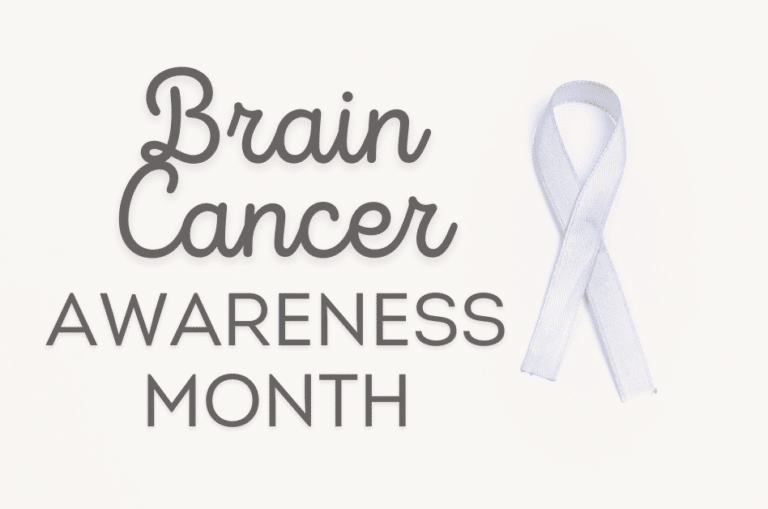
May is known as Brain Tumor Awareness Month. The month of May is dedicated to raising awareness and educating people about the many types of brain cancers and sharing stories from people in the brain tumor community. Sharing real stories helps those recently diagnosed have a better idea of what they might be expect in their journey.
Social media accounts often use the hashtags #GrayMay and #GoGrayInMay to help raise public awareness of brain tumors and start conversations about the brain tumor experience.
The “gray” in those hashtags represents gray matter, which makes up about 40% of the brain.
Understanding the Brain
The brain is an organ in your head that is protected by the skull.
There are three main parts of the brain: the cerebellum, brain stem, and cerebrum.
The cerebrum has four lobes, or sections that each control certain functions: the frontal, parietal, temporal, and occipital lobes.
The brain is often referred to as a central computer – it controls a number of things:
- thinking
- emotions
- language
- movement
- senses
- communication
- memory
It also controls other bodily functions, like the beating of your heart and the digestion of food.
When cells within the brain mutate or change, they start growing quickly. These cells group together, forming a tumor. Tumors can be benign (not cancerous) or malignant (cancerous).
Brain tumors are grouped into two types:
- Primary brain tumors develop within the brain or central nervous system (CNS), which can also include the spinal cord at the base of the skull.
- Secondary brain tumors are tumors that grow in the brain after spreading from another location in the body. The most common types of cancer that can spread to the brain are lung cancer, breast cancer and colon cancer.
Brain tumors are also categorized as either high grade, which means rapidly growing, or low grade, which is a slow growing tumor.
Types of Brain Cancer
There are over 130 different types of brain and primary CNS cancer. This article will talk about the main brain cancers in adults and then review pediatric brain cancer, too.
Gliomas start in the glial cells, which are cells that surround and support the brain neurons.
Gliomas can be low-grade or high-grade. Sometimes, they change from low-grade to high-grade over time.
The types of gliomas are based on the kind of cells where they start in the brain:
- Glioblastoma, also called glioblastoma multiforme or GBM, is an aggressive type of cancer that can be difficult to treat.
- Ependymoma starts in the cells that line the cavities in the brain and the central part of the spinal cord.
- Oligodenroglioma starts in the cells that cover and protect nerve cells in the brain and spinal cord. These tend to be low-grade or slow-growing tumors.
Meningioma starts in the membranes surrounding the brain on the inside of the skull. Most (85%) meningiomas are noncancerous, slow-growing tumors, but some can become cancerous over time.
Pediatric Brain Tumors
Children tend to develop different types of brain tumors than adults, but not always.
Astrocytomas, which are a type of glioma, make up about half of all childhood brain tumors. They mostly affect children between 5 and 8.
Medulloblastoma starts in the cerebellum, which is located at the base of the skull. It’s most common in children between ages 5 and 9. It is rare in people over 30.
Diffuse Intrinsic Pontine Glioma (DIPG) is a rare but fast-growing brain cancer that starts in the brain stem. This can be extremely difficult to treat, with most children with DIPG not living longer than 2 years after their diagnosis.
Statistics/Fast Facts
According to the National Brain Tumor Society, it is estimated that 1 million Americans are living with a brain tumor.
About 70% of brain tumors are not cancerous. Around 30% are cancer.
Men are more likely to develop brain tumors than women.
Caucasian men are at higher risk than other ethnicities for brain cancer.
Brain and spine cancer, which are collectively called central nervous system (CNS) cancers, are rare. In 2024, there will be an estimated 25,400 new cases of brain cancer in the United States. These will make up 1.3% of all new cancer cases diagnosed in 2024.
Almost all cancers have the ability to spread to the brain, causing secondary brain tumors.
Glioblastoma, the most aggressive type of brain cancer has a poor prognosis – the average length of survival after diagnosis is only 8 months, and the five-year survival rate is just 6.9%. That means only 6.9% of glioblastoma patients are still alive 5 years after their diagnosis.
This is one of the reasons why many clinical trials are being conducted – to discover new treatments for this type of cancer. New therapies are needed that are not only effective against these high-grade gliomas, but also minimize the side effects of the tumor and treatments.
Glioblastoma is also one of the most expensive cancers to treat, often leading to major financial struggles on top of dealing with the burdens of the disease.
More than any other cancer, brain tumors are known to have long lasting and life altering cognitive, physical and psychological impact on a patient’s quality of life.
Facts About Brain Tumors in Children and Adolescents
According to the American Cancer Society, brain and spinal cord tumors are the second most common cancer in children and adolescents.
These types of cancers make up 25% of all pediatric cancers.
Almost 5,000 kids and teens will be diagnosed with a brain tumor each year.
Even though significant research progress has been made over the last few decades, brain cancers are still the leading cause of cancer deaths among children and adolescents. 30% of cancer deaths in this age group are caused by brain tumors.
In children, the average five-year survival rate with glioblastoma is better than adults, at around 20%. (This is still far too low for survival rates, highlighting the desperate need for vital research for this type of adult and childhood cancer.)
Because of their location, some pediatric brain tumors and their treatments can cause significant long-term impairment to both intellectual and neurological function.
Around 200-400 children in the U.S. will be diagnosed each year with diffuse intrinsic pontine glioma (DIPG) – an aggressive brain cancer where most children live less than a year after diagnosis.
Because of the rarity of this type of cancer and its devastating effects, a day has been set aside to specifically raise awareness and to call for more research to be done, so that young lives aren’t lost to DIPG. DIPG Awareness Day is recognized on May 17th each year.
Risk Factors
In many cases, the causes of brain tumors are unknown for both children and adults. Some of the risk factors include:
- Exposure to radiation – especially if you’ve had radiation to the brain for a previous tumor, you’re more likely to develop another tumor.
- Exposure to pesticides or other chemicals like solvents, vinyl chloride, rubber and oil products may be linked to brain tumors
- Age – either young children or older adults are at higher risk than middle aged adults
- Some hereditary genetic conditions may contribute to developing a brain tumor
- Gender
- Ethnicity – whites have higher rates of brain tumors than other ethnicities
- Obesity
- A compromised immune system / having an immunodeficiency disorder like HIV or AIDS
Signs & Symptoms
Symptoms of a brain tumor vary, depending on which part of the brain the tumor is located.
Frontal lobe: The frontal lobe controls emotions, movement, and problem-solving. A tumor in this area can lead to behavior or personality changes, trouble speaking, seizures, or numbness/weakness in the arms/hands or feet/legs.
Temporal lobe: The temporal lobe controls memory and hearing. A tumor in this area can cause problems with memory and hearing loss. Seizures can also indicate a temporal lobe tumor.
Parietal lobe: The parietal lobe processes sensory information, like smell, taste, and touch. A tumor in this area can lead to difficulties with spatial awareness, like running into walls or furniture because you can’t judge how close or far away you are from something. Tumors in the parietal lobe can also cause changes in the senses.
Occipital lobe: The occipital lobe processes visual information. A tumor here leads to vision problems, like blurry vision or loss of sight in one or both eyes.
Brainstem: The brainstem controls lots of basic functions, like blood pressure, heart rate, and breathing. Tumors in the brainstem can lead to weakness or loss of coordination. Problems with swallowing or speaking may also occur.
Cerebellum: The cerebellum controls balance and movement. A tumor here can cause problems with balance and coordination.
Pituitary gland: The pituitary gland produces hormones necessary for bodily functions. A tumor here can cause hormonal imbalances, leading to weight gain, weight loss, and changes in appetite.
Other brain tumor symptoms and warning signs to look out for include:
- Nausea and vomiting
- Headaches, especially in the morning or those that go away after vomiting
- Sudden or extreme drowsiness
- Behavior and personality changes
- Seizures, particularly in adults with no history of seizures, or seizures that occur with a headache
- Vision problems: double vision, seeing flashing lights or colors, loss of peripheral vision
- Speech problems: slurring words, difficulty speaking, having trouble finding the words to say
- Cognitive changes; memory loss, difficulty concentrating, confusion
- Hearing loss or ringing in the ears (tinnitus)
These symptoms can come and go for a while, can start slowly and worsen over time, or can appear to come on suddenly and be severe from the beginning.
If you’re experiencing any of these symptoms, it’s important to be evaluated by a doctor to determine their cause. If you do receive a primary brain tumor diagnosis, early detection and treatment may lead to better outcomes.
Diagnosing a Brain Tumor
A doctor will first conduct a physical exam and a neurological exam.
A neurology exam includes checking:
- Muscle strength/weakness
- Mental status
- Senses to see if there are feeling differences on either side of the body
- Reflexes
- Balance
- and more
If the doctor suspects a brain tumor might be causing the symptoms, other tests like blood work and imaging will likely be ordered. These will look for abnormalities in the blood and for any suspicious areas shown on scans.
If something is found, a biopsy will likely be done. This is to rule out benign brain tumors.
If the biopsy shows that the tumor is cancerous, the report will also state which type of cancer it is, which will help your medical team map out the best plan for your cancer care.
Treatment Options for Brain Cancer
Treatment will often include surgery if the tumor is in an area that can be removed.
Some areas of the brain are inoperable, either because they are too deep into the brain or because surgery in that area would damage critical parts of the brain, including the brain stem, the thalamus, and deep areas of gray matter.
Other treatment options include radiation therapy, chemotherapy, or immunotherapy.
Radiation directs beams of radiation specifically to the area where the tumor is located. This is to try to minimize affecting other areas of the brain surrounding the tumor.
Chemotherapy involves medicines that go through your entire body to fight the cancer cells making up the brain tumor. One drawback to this type of treatment is that chemotherapy drugs also affect healthy cells in your body.
Immunotherapy boosts the immune system, helping the body’s natural defense system fight cancer cells.
Often, steroids are prescribed to this patient population as well. Steroids help fight inflammation, reducing the swelling and pressure that brain tumors can place on the skull.
This can greatly reduce symptoms like headaches, blurry vision, and nausea.
Final Thoughts on Brain Cancer Awareness Month
Cancer research has come a long way in diagnosing and treating primary malignant brain tumors, but there is so much more work to be done.
Current treatment options need to be improved so they are more effective in curing brain tumors while also keeping brain tumor patients’ quality of life high during treatment.
Also important in brain tumor research is developing effective treatments that won’t have such long-term, devastating effects on brain tumor survivors.
During Brain Cancer Awareness Month, help spread the word about different types of brain tumors, encourage those with symptoms to get checked out, and provide emotional support to patients going through cancer treatment.
With your help, we can make a positive impact on the state of research and treatment, and especially to those dealing with this type of cancer.



